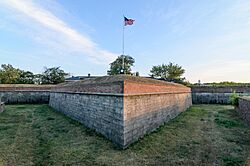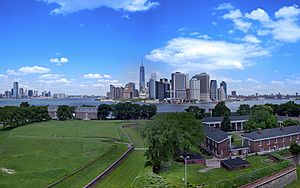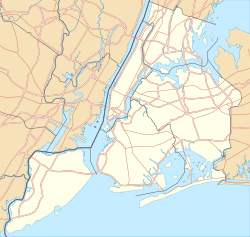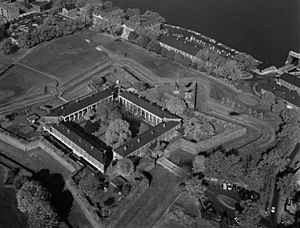Fort Jay facts for kids
Quick facts for kids Fort JayFort Columbus |
|
|---|---|
| Part of Governors Island | |
| New York County, New York, United States | |
 |
|
| Type | Fortification |
| Site information | |
| Owner | Public - National Park Service |
| Controlled by | United States of America |
| Open to the public |
Yes |
|
Fort Jay
|
|
| Visitation | 126,000 (2008) |
| NRHP reference No. | 74001268 |
| Significant dates | |
| Added to NRHP | March 27, 1974 |
| Condition | Good |
| Site history | |
| Built | 1794, 1806, 1833 |
| Built by | U.S. Army Corps of Engineers, Jonathan Williams |
| In use | 1794-1997 |
| Materials | Sandstone, Granite, Brick |
Fort Jay is an old army fort on Governors Island in New York Harbor. It's located right in New York City. This fort is the oldest defense structure on the island.
It was first built in 1794 to protect Upper New York Bay. The fort was named after John Jay, an important leader and one of the Founding Fathers of the United States. From 1806 to 1904, it was called Fort Columbus, likely after Christopher Columbus. Today, Fort Jay is part of the Governors Island National Monument and is managed by the National Park Service.
Contents
Fort Jay's Revolutionary War Role
Fort Jay stands on Governors Island, which was once called Nutten Island. During the American Revolution, in April 1776, General Israel Putnam built the first dirt fort here. It had eight cannons to defend New York Harbor.
These cannons helped protect New York City. On July 12, 1776, the fort's guns fired at two British ships, the HMS Phoenix and the HMS Rose. The damage they caused made the British careful about entering the East River. This caution later helped General George Washington move his troops safely from Brooklyn to Manhattan. This happened after a big battle called the Battle of Brooklyn.
American soldiers left the fort in September 1776. The British then took over New York City. They used the island as a hospital for their navy. The British left on November 25, 1783, and Governors Island became part of New York State.
Building a Stronger Fort
After the British left, the old dirt fort fell apart. In 1794, New York State started to rebuild it. The new fort was square with four corner sections, called bastions. It was named Fort Jay after Governor John Jay.
By 1800, New York State gave Governors Island and Fort Jay to the U.S. government. This allowed the federal government to keep funding and maintaining the fort.
In 1806, the fort was rebuilt again, this time with strong granite and brick walls. Major Jonathan Williams, a chief engineer for the U.S. Army Corps of Engineers, designed the new fort. He made it larger and stronger. The fort had a dry moat (a ditch without water) around it. There was also a grassy slope called a glacis. This slope helped stop cannonballs and gave soldiers a clear view of any approaching enemies. The fort's design and its location on the island's highest point are still visible today. The main walls and gate were finished in 1808. Later, small barracks (buildings for soldiers) were built inside.
Why the Name Changed
The fort was first named Fort Jay after John Jay. He was a very important person: a New York governor, a Chief Justice, and a Secretary of State. He also helped create the United States.
However, in 1800, Thomas Jefferson became President. His political party, the Democratic-Republicans, had different ideas than Jay's Federalist Party. They didn't like a treaty Jay had made with Great Britain.
So, sometime between 1806 and 1807, the fort's name was changed to Fort Columbus. This was likely to honor Christopher Columbus. Some historians think it was because John Jay was not popular with the new government. The fort kept the name "Columbus" for almost 100 years. It finally became Fort Jay again in 1904.
Fort Columbus was very important for defending New York City. It worked with other forts like Fort Wood on Liberty Island and Castle Clinton in Manhattan. This group of forts protected the city and Upper New York Bay. During the War of 1812, these strong defenses helped keep the British navy from attacking New York City.
Fort Jay in the 1800s and Civil War
As new weapons were invented in the 1820s, the fort's role in defense changed. Newer, stronger forts were built at the Narrows of New York Harbor. This made the forts in the Upper Harbor less critical for defense.
However, Fort Columbus was large enough (68 acres) and close enough to Manhattan to remain an important army post. It became a place where soldiers recorded weather observations starting in the 1820s.
Training Future Generals
Fort Columbus was the closest major army post to the United States Military Academy at West Point, New York. Many young officers, fresh out of West Point, came to Fort Columbus before going to other army posts.
Many famous generals from the US Civil War spent time at Fort Columbus as young officers. These included Ulysses S. Grant, Robert E. Lee, Abner Doubleday, and Thomas Jackson.
In the 1830s, the fort was updated. Four new barracks buildings were constructed in 1833. These buildings, still standing today, were made in the Greek Revival style. They housed officers and enlisted soldiers.
The army also set up a recruiting center at Fort Columbus in 1852. Many officers came here to find new soldiers for their regiments.
Civil War Events
Fort Columbus played a secret role at the start of the US Civil War. In December 1860 and April 1861, troops and supplies were sent from Fort Columbus to help soldiers at Fort Sumter in Charleston, South Carolina.
The first attempt failed when a ship called the Star of the West was fired upon. This event made more southern states consider leaving the Union. The second attempt also failed and led to the firing on Fort Sumter on April 12, 1861, which started the Civil War.
During the early Civil War, the fort's barracks held Confederate officers captured in battle. Fort Columbus and Castle Williams also served as temporary prison camps and hospitals for Confederate prisoners. Major General William H. C. Whiting, a high-ranking Confederate officer, died here in 1865.
Later in the war, the fort's weapons were upgraded with large Rodman guns. These were huge cannons, some 10-inch and some 15-inch. During World War II, most of these guns were melted down for scrap metal. However, four 10-inch and one 15-inch gun were kept as decorations at the fort's entrance.
A Major Army Headquarters
After the Civil War, the New York Arsenal, next to Fort Columbus, became a center for getting rid of extra cannons and ammunition. These were used for war memorials, sold as scrap, or sold to other countries.
In 1878, the U.S. Army moved many of its offices from rented buildings in New York City to Governors Island. This made Fort Columbus the main headquarters for army activities in almost all states east of the Mississippi River. Being stationed at Fort Columbus was a very important job, second only to high-ranking positions in Washington, D.C.. Many commanders here later became top generals for the entire U.S. Army.
Fort Jay in the 1900s

Around 1900, President Theodore Roosevelt's Secretary of War, Elihu Root, wanted to improve Governors Island. He wanted to make it better for the army and prevent New York City from taking it over for a city park. He also wanted to provide quick federal protection for important financial areas in Lower Manhattan.
Root oversaw the expansion of the island from 60 acres to 172 acres using landfill. He also hired architects to create a new plan for the island. This plan kept the three original forts, including Fort Jay, showing his interest in preserving history. In 1904, Root officially changed the fort's name back to Fort Jay.
In the 1930s, the barracks inside Fort Jay were changed into family homes for junior officers. Garages were also built for cars.
During World War II, Fort Jay was a very important place. It was the headquarters for the United States First Army and later the Eastern Defense Command. This command was in charge of all army units and defenses in the northeastern United States, from Maine to Florida.
Becoming a National Monument
In November 1964, the U.S. Army announced that Fort Jay would close. The army's duties were moved to Fort George G. Meade in Maryland. In 1966, the United States Coast Guard took over Governors Island. They used Fort Jay to house officers until their base on Governors Island closed in September 1996.
On January 19, 2001, Fort Jay, along with Castle Williams and 23 acres around them, became part of the Governors Island National Monument. It is now managed by the National Park Service. Fort Jay is recognized as one of the best examples of early American military forts. Since 2003, both forts have been open to the public during the summer.
See also
 In Spanish: Fort Jay para niños
In Spanish: Fort Jay para niños






